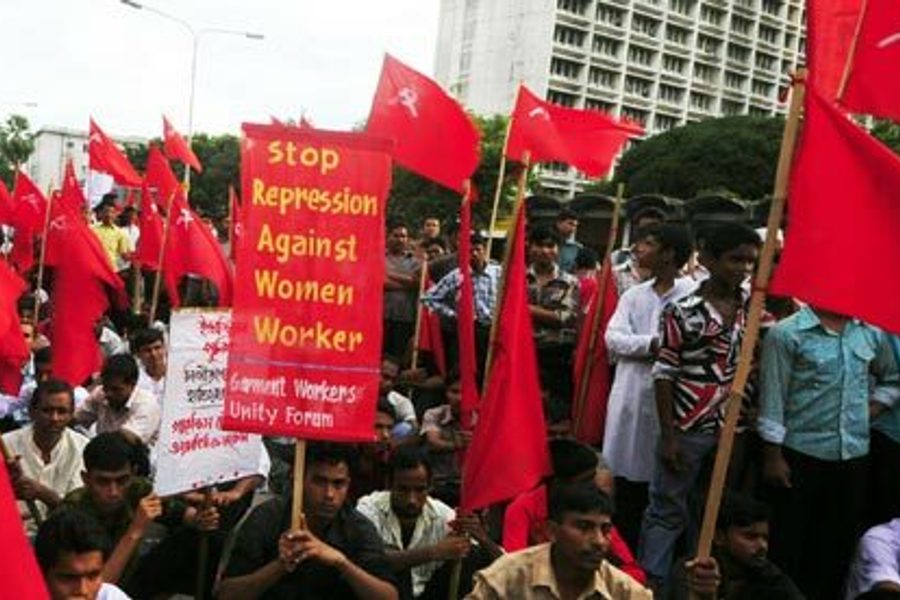
Garment factories have been fleeing from the American industrial landscape for decades now, and their destination is no mystery: faraway communities where the impoverished will work longer, for less, under worse conditions. The workers left behind can do little but watch in distress as the global labor system continues to spiral downward. But awaiting those factories today are labor advocates in Asia who are determined to draw the line on the race to the bottom, by pushing up the floor.
A group of workers’ advocates came together in 2009 to launch the Asia Floor Wage Alliance, an unprecedented effort to do what free-trade agreements have done for global capital: establish an economic baseline that transcends national boundaries. But while multinationals have prowled the planet to exploit the cheapest workforces they can find, advocates call for a common living wage standard to ensure that workers from Shenzhen to Sri Lanka aren’t working themselves deeper into poverty.
The Great Recession offers an opportunity to begin reconfiguring the profit structure. The Wage Floor campaign presents itself as “an effort to formulate a different way to think about developing a global industry and rebuilding the global economy, by raising wages at the bottom and reducing inequality.”
This month, the Asia Floor Wage Alliance (AFW) has stepped up pressure on the garment industry, including household names like Gap and Addidas, by issuing guidelines on the living wage in the countries it campaigns in. The projected monthly living wage figures for 2011 are:
Bangladesh: 12248 BDT
Cambodia: 692903 Riel
India: 7967 Rupees
Indonesia: 2132202 Rupiah
Sri Lanka: 19077 Rupees
China: 1842 RMB(Convert to US dollars here.)
In Asia as in America, low-wage workers, especially women, suffer a vast discrepancy between the legal minimum wage and what it actually takes to support a household. According to the AFW Alliance, “Currently, the gap between the minimum wage and Asia Floor Wage is almost 1:2, in the best case scenario.”
The issue is especially acute for China, where rising inflation and U.S. pressure over Beijing’s currency policy could impact purchasing power and labor costs both in China and all the markets that its factories feed. In the long run, across the region, there is the tumult of soaring food prices, climate change, migration into dense urban areas and a drive for higher living standards. The very least governments and employers could do is work with civil society to align workers’ base incomes with economic security and, by extension, social stability.
Of course, the AFW initiative will meet resistance from the industry. Executives may grumble that higher wages will translate into job losses or higher prices for Americans. True, rising labor costs may have unpredictable ripple effects on workers and consumers in developed and developing economies. But volatility is already endemic in global trade. A coordinated movement to establish a firm wage floor, in consultation with workers, unions and employers, lays the foundation for a more rational the production chain, in which fair wages and fair prices are in harmony, and the bosses on top finally get squeezed to pay their fair share.
Grassroots campaigns launched by garment workers and activists since 2009 have raised awareness of the need for decent wages to hold the line against unbridled profiteering in the poorest countries. Like cross-border union organizing, the concept of living wage standards across the Global South introduces a principle of equity that companies can’t escape from simply by moving a factory to a neighboring country.
The age of globalization has led to a yawning gap not just between rich and poor, but in the expectations of what the rich and the poor should survive on and aspire to. Lax borders for multinational employers are juxtaposed against hostile immigration policies and ruthless offshoring of jobs. A guaranteed living wage, regardless of where a worker lives, won’t revolutionize the garment industry. But it strengthens the push back against a tide of injustice that perhaps just a few years ago, seemed unstoppable.
Michelle Chen is a contributing writer at In These Times and The Nation, a contributing editor at Dissent and a co-producer of the “Belabored” podcast. She studies history at the CUNY Graduate Center. She tweets at @meeshellchen.








